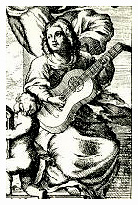

Syukhtun Editions



It is generally accepted that composer Gaspar Sanz was born on April 4, 1640, in Calanda in the region of Aragon, Spain. As a young man, he received a bachelor of theology degree and subsequently took the vows of Holy Orders from the University of Salamanca. But the spirituality of music would become a second vocation for Sanz and he journeyed to Italy to study music with Cristofaro Caresana and Lelio Colista, as well as (speculatively) Orazio Benevoli and Pietro Andrea Ziani.
Upon his return to Spain, he pursued literature, religion, and music in equal measure with, respectively, a translation of Bartoli (1678), a eulogy to Pope Innocent XI (1681), and his musical magnum opus in the three-volume Instruccion de musica sobre la guitarra Espanola. His musical prowess soon came to loom over his other achievements, becoming widely regarded as the foremost guitar theorist of his day as well as private instructor of guitar to Don Juan of Austria, the dedicatee of his Instruccion. A complete musician, Sanz was also organist to the viceroy of Napoles. He is believed to have died in Madrid in 1710.
By the time Sanz began his work, the guitar in its evolution had acquired a fifth course (string pair) and settled into the fourths-oriented tuning that led to the modern six-string guitar as is known today, the octave pairing of the lower strings surviving in the modern 12-string guitar. Sanz took advantage of these developments in the 90 pieces that comprise the three volumes of Instruccion. The result is of two-fold musical importance.
First, the capabilities of the guitar, by this time achieving a status comparable to the lute as a serious instrument, were extended, moving away from the single-line melodic stretches punctuated by chords; although the said idiom may be found in the first volume, geared toward the novice, the subsequent volumes find writing for more active right-hand technique, independence of the thumb and fingers, and more varied and at times contrapuntal texture. All this is prefaced in the first volume by a tutorial, a manual for care of the instrument, and an essay on figured bass for the guitar. The music in the three volumes is written in tablature, although later arrangements for standard notation have since been made.
The second great significance of the Sanz set is that it contains many examples of Spanish folk songs and dances, exposing these to the world at large. Some, like the Zarabanda, feature an alternation of meters that presage the flamenco guitar idiom. Also can be found are the more conventional forms of passacaglia, pavan, and galliard, as well as travel souvenirs such as a Neopolitan piece. Together, these reveal Gaspar Sanz to be a well-rounded and cosmopolitan musician for his time, as well as a prophet for an instrument that would one day rival the keyboard in popularity. (Wayne Reisig, All Music Guide)

